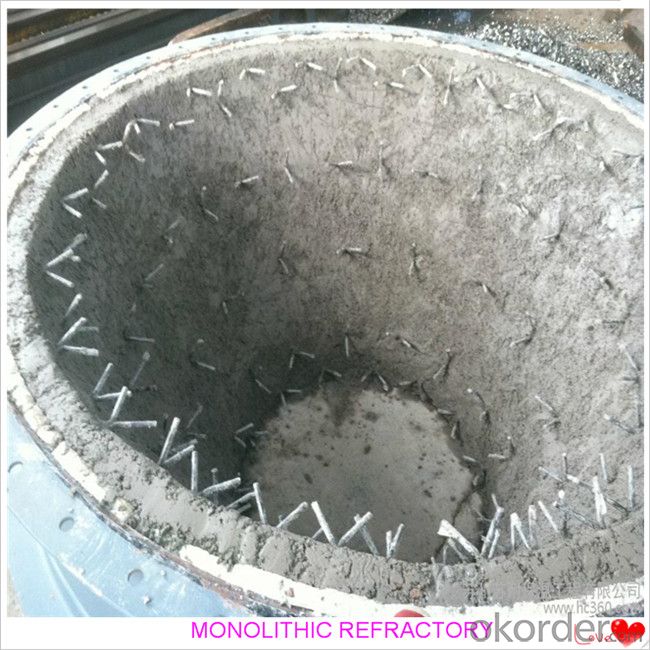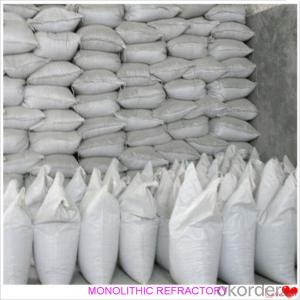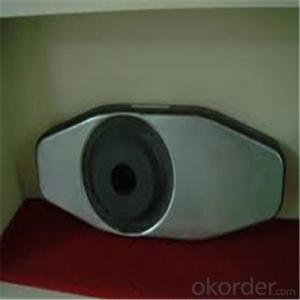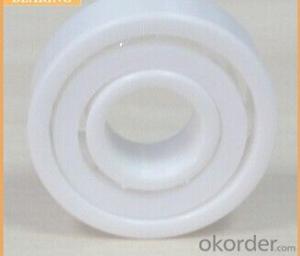Monolithic Refractories for Iron and Steel Industry - Fireclay Castable for Fireplace and Industrial Furnace
- Loading Port:
- China main port
- Payment Terms:
- TT OR LC
- Min Order Qty:
- 1000 kg
- Supply Capability:
- 3000000 kg/month
OKorder Service Pledge
OKorder Financial Service
You Might Also Like
Fireclay Castable For Fireplace and Industrial Furnace in Iron and Steel
Product Description:
Fireclay Castable is manufactured according to international standards. The product is famous for its excellent abrasion resistance and low thermal conductivity. Further, these can be provided in different specifications as required by the clients. The Fireclay Castables are used high purity raw materials and additives as the main material, and made of under superfine powder adding technology.
Product Advantages:
The material has excellent structural stability and air tightness, and has high physical and chemical properties, also has a fine working ability.They should be used with the same material products.
Product Applications:
For feature of Fireclay Castable, they have excellent abrasion resistance, thermal shock resistance, high-temperature resistance, anti-corrode and have high intensity.
Designed for refractory lining of blast furnace iron and slag runners, skimmers and soon
They can be used in troughs of small and mid size BFs and in all positions of the troughs where fast tapping is required.
Product Specifications:

FAQ:
1. How you can control your quality?
For each production processing, we have complete QC system for the chemical composition
and Physical properties. After production, all the goods will be tested, and the quality certificate
will be shipped along with goods.
2. What's your delivery time?
It usually needs about 20days- 45 days after receiving the deposit.
3. Do you provide free samples?
Yes, we can provide a free sample for testing, If we have sample in stock,
The quantity based on the material type, The buyer should bear all the shipping costs.
4. What's your payment terms?
We can accept 30% deposit, 70% balance before shipment for ordrs over $ 2000.
5. Can we visit your Company?
Yes, certainly. You are very welcome to China and we will be honored to have a customer and friend.
Product Picture:




- Q: How do monolithic refractories resist abrasion in the iron and steel industry?
- Monolithic refractories in the iron and steel industry resist abrasion through their inherent properties and design features. These refractories are formulated with high levels of abrasion-resistant materials such as alumina, silicon carbide, and zirconia, which provide excellent resistance to wear and erosion caused by the movement of molten metal, slag, and other abrasive materials in the production processes. Additionally, the monolithic nature of these refractories eliminates the presence of joints and gaps, reducing weak points and enhancing their ability to withstand abrasion.
- Q: What are the quality control measures for monolithic refractories in the iron and steel industry?
- To ensure the efficiency and safety of the production process in the iron and steel industry, it is crucial to implement quality control measures for monolithic refractories. These measures encompass a range of inspections and tests throughout the manufacturing and installation stages. To begin with, rigorous testing is conducted on the raw materials used for monolithic refractories. This involves analyzing the chemical composition, particle size distribution, and impurity content. These tests are essential to ensure that the ingredients meet the required specifications and are suitable for the intended application. During the production process, the focus of quality control measures lies in monitoring the mixing and blending of the materials. This ensures that a homogeneous mixture is achieved, preventing any inconsistencies in the final product. Additionally, the density and viscosity of the refractory castables or plastics are checked to maintain the desired physical properties. Once the monolithic refractories are manufactured, they undergo several performance tests. These tests involve determining properties such as cold crushing strength, modulus of rupture, and thermal conductivity. These characteristics are crucial in ensuring that the refractories can withstand the extreme temperatures and mechanical stress present in the iron and steel industry. Aside from laboratory testing, quality control measures also involve on-site inspections during installation. This includes verifying the correct application techniques, such as proper vibration, curing, and drying procedures. It is of utmost importance to ensure that the monolithic refractories are applied correctly to achieve optimal performance and longevity. Furthermore, regular sampling and monitoring of the refractories' performance are carried out during operation. This allows for the early detection of any signs of degradation or wear, enabling proactive maintenance and replacement before any significant issues arise. In conclusion, the quality control measures for monolithic refractories in the iron and steel industry encompass comprehensive testing, monitoring, and inspection procedures. These measures are implemented to guarantee the reliability, durability, and efficiency of the refractories, ultimately contributing to the smooth operation of the iron and steel production processes.
- Q: How are monolithic refractories recycled or disposed of at the end of their lifespan?
- Monolithic refractories, which are commonly used in high-temperature industrial applications, can be recycled or disposed of at the end of their lifespan through several methods. The chosen method depends on the specific type of monolithic refractory and its composition. One common approach to recycling monolithic refractories is through a process known as reclamation. Reclamation involves collecting used refractory materials and processing them to remove any impurities or contaminants. The reclaimed refractory material can then be crushed, ground, or milled to produce a fine powder that can be used as a raw material in the production of new refractories. Another method of recycling monolithic refractories is through thermal treatment. This involves subjecting the used refractory material to high temperatures in a controlled environment, such as a kiln or furnace. The heat helps to break down the refractory material, removing any binders or impurities. The resulting material can then be reused as a raw material or incorporated into other applications, such as aggregates for construction. In cases where recycling is not feasible, monolithic refractories can be disposed of in specialized facilities designed for handling and treating hazardous waste. These facilities ensure that the refractory material is properly contained and treated to minimize any potential environmental impact. This disposal method is typically used for refractories that contain hazardous substances or cannot be recycled due to their composition. It is important to note that the proper disposal or recycling method for monolithic refractories should comply with local regulations and guidelines. These regulations aim to ensure the safe handling, treatment, and disposal of these materials, taking into consideration their potential environmental and health impacts. Therefore, it is crucial for industries and businesses to work closely with waste management professionals and follow the appropriate procedures to responsibly manage monolithic refractories at the end of their lifespan.
- Q: What are the challenges in recycling monolithic refractories?
- Recycling monolithic refractories presents several challenges that complicate the process compared to other materials. To begin with, the exceptional resistance of monolithic refractories to high temperatures and harsh conditions makes them difficult to break down and separate. Specialized techniques and equipment are required for this purpose. Furthermore, monolithic refractories often contain various additives and binders, such as clay, cement, and other organic compounds. These additional substances add complexity to the recycling process, as they may need to be removed or separated from the refractory material before effective recycling can take place. Moreover, monolithic refractories are prone to contamination during their service life, with metal oxides, slag, and impurities being common culprits. These contaminants can affect the quality and properties of the recycled refractory material, necessitating thorough cleaning and purification procedures. Additionally, the logistics involved in collecting and transporting monolithic refractories for recycling can be challenging. Given that refractories are typically used in large quantities in industrial settings, their removal and transportation can be costly and time-consuming. Furthermore, finding suitable recycling facilities equipped with the necessary expertise and equipment to handle monolithic refractories can be limited, particularly in certain regions. Lastly, economic factors contribute to the challenges of recycling monolithic refractories. The financial viability of recycling and processing these refractories may not always justify the cost compared to using new materials. Consequently, companies may be discouraged from investing in recycling programs, leading to lower demand for recycled refractory materials. In summary, the challenges associated with recycling monolithic refractories primarily arise from their durability, complex composition, contamination, logistics, and economic considerations. Nonetheless, with technological advancements and increased awareness of the environmental benefits of recycling, these challenges can be overcome, promoting the sustainable reuse of refractory materials.
- Q: What are the challenges in recycling and disposing of monolithic refractories?
- Recycling and disposing of monolithic refractories pose several challenges that need to be addressed in order to minimize environmental impact and maximize resource efficiency. One of the main challenges is the handling and transportation of monolithic refractories due to their heavy and bulky nature. These materials are often used in high-temperature applications, such as furnace linings, and can be difficult to dismantle and remove from equipment. The weight and size of monolithic refractories make it challenging to transport them to recycling or disposal facilities, requiring specialized equipment and infrastructure. Another challenge is the heterogeneity of monolithic refractories, which often contain various types of refractory materials, binders, and additives. This complexity makes it difficult to separate and categorize different components for effective recycling. The lack of standardized recycling processes for monolithic refractories further complicates the recycling efforts. Furthermore, the high melting points of refractory materials used in monolithic refractories can make it energy-intensive and costly to recycle them through conventional methods like melting and remolding. Alternative recycling methods, such as thermal treatment or chemical processing, need to be explored and optimized to make the recycling process more economically and environmentally viable. Ensuring the proper disposal of monolithic refractories is also a challenge. If these materials are not recycled, they often end up in landfills, taking up valuable space and potentially leaching harmful substances into the environment. Landfilling refractories can also pose a risk of contamination if they are not properly managed or if hazardous additives are present in the materials. To address these challenges, it is crucial to invest in research and development to develop more efficient and cost-effective recycling technologies for monolithic refractories. Collaboration between manufacturers, recycling facilities, and regulatory bodies is also essential to establish guidelines and standards for the recycling and disposal of these materials. Additionally, educating industries and end-users about the importance of recycling and the availability of recycling options can help increase the demand and feasibility of recycling monolithic refractories.
- Q: How do monolithic refractories contribute to the overall safety of iron and steel operations?
- Monolithic refractories play a crucial role in ensuring the overall safety of iron and steel operations. These refractories are designed to withstand extreme temperatures, chemical reactions, and mechanical stresses, providing a protective barrier to the furnaces, ladles, and other equipment used in these operations. By maintaining the integrity of the refractory lining, monolithic refractories prevent leaks, minimize the risk of thermal shock, and reduce the chances of equipment failure or accidents. This helps to safeguard the workers, prevent damage to the infrastructure, and ensure the uninterrupted production of iron and steel, thus contributing to the overall safety of the operations.
- Q: What are the environmental considerations associated with monolithic refractories?
- The environmental considerations associated with monolithic refractories primarily revolve around their production and disposal. The manufacturing process of monolithic refractories involves high energy consumption and emissions, contributing to carbon dioxide and other greenhouse gas emissions. Additionally, some raw materials used in their production, such as silica, can have negative environmental impacts during extraction. In terms of disposal, monolithic refractories are typically difficult to recycle due to their composition and structure. As a result, they often end up in landfills, which can contribute to pollution and waste management issues. Overall, the environmental considerations associated with monolithic refractories highlight the need for sustainable manufacturing practices, improved waste management strategies, and the development of alternative refractory materials that have less negative environmental impact.
- Q: How do monolithic refractories improve the performance of iron and steel furnaces?
- Monolithic refractories play a crucial role in enhancing the performance of iron and steel furnaces through various means. Firstly, these refractories offer exceptional thermal insulation, which helps maintain a stable and high temperature within the furnace. This is of utmost importance as the production of iron and steel necessitates extremely high temperatures for efficient melting and refining processes. Secondly, monolithic refractories possess remarkable resistance to thermal shock and can endure rapid temperature fluctuations without cracking or spalling. This is particularly significant in iron and steel furnaces where temperature fluctuations can be substantial during operations. By withstanding thermal shock, these refractories ensure the durability of the furnace lining, thereby reducing the need for maintenance and minimizing downtime. Moreover, monolithic refractories display excellent resistance to chemical attacks caused by the molten metal and slag in the furnace. The production of iron and steel involves the use of various chemical agents that can corrode and erode the furnace lining. Monolithic refractories offer superior resistance to these chemical attacks, preserving the integrity of the furnace lining and preventing contamination of the metal being produced. Additionally, monolithic refractories possess exceptional mechanical strength and abrasion resistance. This is crucial as they are subjected to mechanical stresses and wear resulting from the movement of materials inside the furnace, such as charging and tapping operations. The high mechanical strength and abrasion resistance of these refractories ensure their durability and prolong their service life in iron and steel furnaces. In conclusion, monolithic refractories enhance the performance of iron and steel furnaces by providing superior thermal insulation, resistance to thermal shock and chemical attacks, as well as high mechanical strength and abrasion resistance. These properties contribute to the efficient and reliable operation of the furnace, resulting in increased productivity, reduced maintenance costs, and improved product quality.
- Q: What are the factors to consider when selecting monolithic refractories for specific applications?
- When choosing monolithic refractories for specific applications, one must take into account several factors. These factors encompass the operating temperature, chemical environment, mechanical stress, and desired performance characteristics of the refractory material. The operating temperature plays a pivotal role and varies depending on the monolithic refractory. It is crucial to select a refractory material that can withstand the specific temperature range without experiencing thermal spalling or degradation. The chemical environment also plays a vital role. Different applications may expose the refractory to various chemicals, acids, alkalis, or gases. It is essential to choose a monolithic refractory that is chemically resistant to the specific environment to ensure durability and performance over time. Mechanical stress is another critical consideration. Certain applications may subject the refractory to high mechanical stress, such as abrasion, impact, or thermal shock. It is important to choose a refractory material that can withstand these stresses without cracking or failing. The desired performance characteristics of the refractory material should also be taken into account. This includes factors such as thermal conductivity, thermal expansion, density, and strength. The specific requirements of the application will dictate the necessary performance characteristics, and the refractory material should be chosen accordingly. Other factors to consider include the method of installation, availability, cost, and maintenance requirements. Some monolithic refractories may require specialized installation techniques, while others may be readily available and cost-effective. Additionally, the maintenance requirements of the refractory material should be considered to ensure ease of upkeep and longevity. In conclusion, selecting the appropriate monolithic refractories for specific applications necessitates careful consideration of factors such as operating temperature, chemical environment, mechanical stress, desired performance characteristics, installation method, availability, cost, and maintenance requirements. By taking these factors into account, one can choose a refractory material that will provide optimal performance and durability in the given application.
- Q: How do monolithic refractories improve the efficiency of ladle and tundish lining systems?
- Monolithic refractories play a crucial role in improving the efficiency of ladle and tundish lining systems in several ways. Firstly, monolithic refractories are made from a single piece of material, which eliminates the need for joints or seams. This seamless construction ensures that there are no weak points in the lining system, reducing the risk of leakage or infiltration of molten metal. Additionally, monolithic refractories offer excellent thermal insulation properties. They have low thermal conductivity, meaning they can withstand high temperatures without transferring heat to the surrounding environment. This insulation capability minimizes heat loss from the ladle or tundish, allowing for better heat retention and energy efficiency. It also helps maintain the desired temperature of the molten metal, preventing premature solidification and maintaining the desired fluidity for casting. Furthermore, monolithic refractories offer superior resistance to chemical attacks from molten metal and slag. They have excellent corrosion resistance properties, ensuring that the lining remains intact and durable even when exposed to aggressive chemical reactions. This resistance to corrosion extends the lifespan of the lining system, reducing the frequency of maintenance and replacement, thereby improving overall efficiency and reducing downtime. Another advantage of monolithic refractories is their ease of installation. Unlike traditional brick or block linings, monolithic refractories can be applied as a single, uniform layer, making the installation process simpler and quicker. This reduces the time required for lining repairs or replacements, minimizing production interruptions and improving the overall operational efficiency of ladles and tundishes. In summary, monolithic refractories improve the efficiency of ladle and tundish lining systems by providing seamless construction, excellent thermal insulation, superior corrosion resistance, and easy installation. These characteristics ensure better heat retention, reduced heat loss, increased durability, and minimized downtime, resulting in improved productivity and cost-effectiveness for metal casting processes.
Send your message to us
Monolithic Refractories for Iron and Steel Industry - Fireclay Castable for Fireplace and Industrial Furnace
- Loading Port:
- China main port
- Payment Terms:
- TT OR LC
- Min Order Qty:
- 1000 kg
- Supply Capability:
- 3000000 kg/month
OKorder Service Pledge
OKorder Financial Service
Similar products
Hot products
Hot Searches
Related keywords































